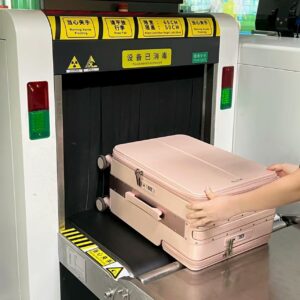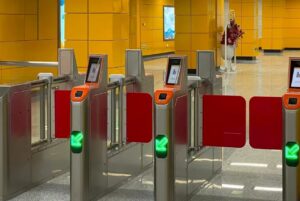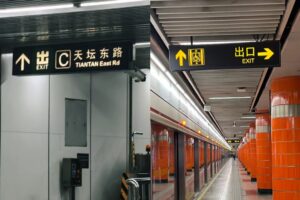The Worst Times to Visit Chongqing
Beijing subway isn’t just transportation—it’s your key to unlocking the city efficiently, affordably, and authentically.
Navigating Beijing Subway Lines and Maps
The Subway Map

Beijing’s subway is a color-coded network with 27+ lines connecting all key attractions, business districts, and transport hubs. Lines are numbered (Line 1, Line 2) or named (e.g., Airport Express). Key features:
-
Colors = Lines: Each line has a unique color (e.g., Line 1: Red, Line 10: Royal Blue).
-
Interchange Stations: Look for hollow circles (●) on the map – these allow transfers between lines (e.g., Xizhimen Station: Lines 2, 4, 13, Airport Express).
-
Airport Links: Airport Express Line (Gold) connects PEK (Terminals 2/3) and PKX (Daxing) to downtown.
How to Choose Your Route
Identify Your Destination Station:
-
Use station names in Pinyin (English letters) – e.g., "Tiān’ānmén Dōng" (天安门东) for Tian’anmen East.
-
Major attractions have direct station names (e.g., "Olympic Green", "Beijing Zoo").
Use Real-Time Tools:
-
Baidu Maps or Apple Maps: Enable English mode, enter destination → "Subway" route shows line colors, transfer points, and travel time.
-
Offline Tip: Download the "Explore Beijing Subway" app (iOS/Android) for English map access without Wi-Fi.
Quick Reference for Top Destinations:
| Destination | Station Name (English) | Line(s) | Notes |
| Forbidden City | Tian’anmen East (东站) | Line 1 (Red) | 5-min walk to East Gate; avoid Wangfujing Station (closer to shopping) |
| Summer Palace | Beigongmen (北宫门) | Line 4 (Light Green) | North Gate entrance; use Exit D |
| Temple of Heaven | Tiantan Dongmen (天坛东门) | Line 5 (Purple) | East Gate entrance; park opens at 6 AM |
| Sanlitun Bar District | Tuanjiehu (团结湖) | Line 14 (Light Blue) | Exit A for Taikoo Li/Sanlitun SOHO; 10-min walk |
| Olympic Park (Bird’s Nest) | Olympic Green (奥林匹克公园) | Line 8 (Green) | Direct access to stadiums; use Exit B |
| Lama Temple | Yonghegong (雍和宫) | Lines 2/5 (Blue/Purple) | Exit F; temple closes at 4:30 PM |
| Great Wall (Mutianyu) | Dongzhimen (东直门) | Lines 2/13 (Blue/Orange) | Transfer point: Take Bus 916 Express (1hr) → Mutianyu shuttle bus |
Detailed Lines Information
4 Major Lines
-
Line 1 (Red Line):
-
Operating Hours: 5:00 AM – 11:00 PM
-
Frequency: Every 3-5 minutes during peak hours, 6-8 minutes off-peak.
-
Coverage: Key tourist spots like Tiananmen Square, Wangfujing, and the Forbidden City.
-
Peak-Hour Passenger Flow: High, especially between 8:00 AM – 9:30 AM and 5:30 PM – 7:00 PM, particularly around major tourist stations.
-
-
Line 2 (Blue Line):
-
Operating Hours: 5:00 AM – 11:30 PM
-
Frequency: Every 3-6 minutes.
-
Coverage: Beijing Railway Station, Dongzhimen (for airport transfer), and areas around the Old City.
-
Peak-Hour Passenger Flow: Moderate to high, with crowds peaking from 7:30 AM – 9:00 AM and 5:30 PM – 7:30 PM, especially near Beijing Railway Station.
-
-
Line 4 (Green Line):
-
Operating Hours: 5:00 AM – 11:00 PM
-
Frequency: Every 4-7 minutes.
-
Coverage: Famous landmarks such as the Summer Palace, Beijing Zoo, Xizhimen, and Haidian.
-
Peak-Hour Passenger Flow: High, especially between 7:00 AM – 9:00 AM and 5:00 PM – 7:00 PM at major transfer stations like Xizhimen.
-
-
Airport Express (Light Blue Line):
-
Operating Hours: 6:00 AM – 10:30 PM
-
Frequency: Every 15 minutes.
-
Coverage: Direct line from the city center to Beijing Capital International Airport.
-
Peak-Hour Passenger Flow: High during flight arrival and departure times, especially between 9:00 AM – 12:00 PM and 4:00 PM – 7:00 PM.
-
Other Lines
-
Line 5 (Purple Line):
-
Operating Hours: 5:00 AM – 11:00 PM
-
Frequency: Every 5-8 minutes.
-
Coverage: Passes through Beijing South Railway Station and residential areas in the south.
-
-
Line 10 (Light Green Line):
-
Operating Hours: 5:00 AM – 11:30 PM
-
Frequency: Every 5-7 minutes.
-
Coverage: Central Business District (CBD), stops near Guomao, and the East Second Ring Road.
-
-
Line 7 (Dark Purple Line):
-
Operating Hours: 5:00 AM – 11:00 PM
-
Frequency: Every 4-7 minutes.
-
Coverage: Commercial areas like Beijing West Railway Station, Zhaogongkou.
-
-
Line 6 (Light Purple Line):
-
Operating Hours: 5:00 AM – 11:00 PM
-
Frequency: Every 5-8 minutes.
-
Coverage: Stations like Dongdaqiao and Chaoyangmen, passing through busy residential areas.
-
-
Line 3 (Orange Line):
-
Operating Hours: 5:00 AM – 11:00 PM
-
Frequency: Every 5-7 minutes.
-
Coverage: National Library, Fuxingmen.
-
-
Line 13 (Dark Green Line):
-
Operating Hours: 5:00 AM – 11:00 PM
-
Frequency: Every 6-8 minutes.
-
Coverage: Northwestern districts of Beijing, passes near major residential areas.
-
-
Line 14 (Light Blue Line):
-
Operating Hours: 5:00 AM – 11:00 PM
-
Frequency: Every 5-8 minutes.
-
Coverage: Central districts like Chaoyang, with stops near Beijing’s central business and residential areas.
-
-
Line 15 (Sky Blue Line):
-
Operating Hours: 5:00 AM – 11:00 PM
-
Frequency: Every 6-9 minutes.
-
Coverage: Suburban and residential areas in Beijing’s northeast.
-
-
Line 9 (Light Brown Line):
-
Operating Hours: 5:00 AM – 11:00 PM
-
Frequency: Every 5-10 minutes.
-
Coverage: Beijing West Railway Station, residential districts in the southern part of the city.
-
-
Line 16 (Dark Brown Line):
-
Operating Hours: 5:00 AM – 11:00 PM
-
Frequency: Every 6-8 minutes.
-
Coverage: Suburban and residential areas in Beijing’s northeastern districts.
-
-
Line 17 (Dark Blue Line):
-
Operating Hours: 5:00 AM – 11:00 PM
-
Frequency: Every 6-8 minutes.
-
Coverage: Serving the suburban Changping district and major residential areas.
-
Beijing Subway Station Survival Guide
Security Checks

-
Process: All passengers are required to go through security checks before entering subway stations. This includes passing through a metal detector and scanning your bags.
-
Prohibited Items: Weapons, explosives, large liquids, and dangerous chemicals are strictly prohibited. Ensure you don’t carry large, sharp objects that may be flagged during the inspection.
Payment Methods

-
QR Code Payment (Recommended)
Apps: Alipay or WeChat Pay (works at all stations)
How to Set Up:
1. Download & Register:
Alipay: iOS/Android | WeChat Pay: iOS/Android
2. Link International Card:
In Alipay: Go to Me → Bank Cards → Add Visa/Mastercard.
Note: UnionPay cards work instantly; foreign cards may require 3D verification.
3. Activate "Transport Card":
In Alipay: Search "Beijing Subway" → Tap "Metro" → Authorize auto-deduction.
No top-up needed! Fares deduct directly post-ride (receipt in app).
Key Advantages:
-
No deposit (vs. physical cards)
-
Real-time fare calculation (no overpay)
-
Works across buses, taxis, bikes
Troubleshooting🚫 If QR fails at gates:
-
Check Bluetooth/NFC is on.
-
Scan at yellow QR readers (not blue IC card readers).
-
Single Journey Tickets (Cash Only)
Where: Red self-service machines (select "English" → choose station → insert cash).
Cost: ¥3–¥9 (based on distance).
Limitations:
-
Machines accept ¥1, ¥5, ¥10 coins/bills (no ¥50/¥100).
-
No change given – use exact amounts.
-
Not reusable – repurchase per ride.
-
Beijing Transit Card (一卡通 Yīkǎtōng)
Where to Buy: Service counters at major stations (e.g., Beijing West, Dongzhimen, Capital Airport).
Cost: ¥20 deposit + top-up (recommend ¥50–¥100).
Usage: Tap on/off at blue card readers.
Refunds: Get deposit + balance back at any line’s endpoint station (e.g., Line 1’s Pingguoyuan).
Transfer Tips
Beijing’s subway transfers can involve 5–15 minute walks between lines. Understanding signage and timing is critical. Here’s exactly what to do:
Following Transfer Signs

-
Look for Color-Coded Arrows
-
Blue Signs (换乘 Huànchéng): Indicate transfer paths.
-
Line Color + Arrow: Follow the color of your target line (e.g., Red arrow → Line 1).
-
-
Key Signage Terms (English/Chinese)
| Sign Text | Meaning | Visual Cue |
| 换乘 Line [X] | Transfer to Line X | Line color + walking figure → |
| 出口 EXIT | Station exit (avoid!) | Green background |
| 30m → Line 10 | 30-meter walk to Line 10 | Distance + direction arrow |
Entering/Exiting Efficiently
-
Choose the Right Exit
-
Stations have A, B, C, D... exits (marked in English).
-
Check Maps Before Exiting: Exit letters are shown on platform screens before arrival.
-
-
Re-Entry After Mistaken Exit
-
If you accidentally exit during transfer:
-
Find staff at service counter.
-
Show original QR code/ticket + passport.
-
Request "Jìxù huànchéng" (继续换乘 – continue transfer) for free re-entry.
-
-
Etiquette and Tips for Riding the Subway
Core Etiquette Rules
-
No Eating or Drinking
-
-
🚫 Strictly prohibited (fines up to ¥500).
-
✅ Exception: Plain water in sealed bottles.
-
-
-
Queue Smartly at Platforms
-
Stand beside doors (not in front) to let passengers exit first.
-
Look for yellow ground markers indicating boarding queues.
-
-
Offer Priority Seats
-
Red/Orange seats are reserved for: Seniors, pregnant travelers, disabled passengers, children.
-
Stand immediately if these groups board.
-
-
Keep Voices Low
-
Loud conversations/calls draw stares. - Use headphones for media.
-
-
Manage Luggage Wisely
-
Oversized bags (e.g., backpacks) must be floor-held during rush hours (7–9 AM, 5–7 PM).
-
Blocking aisles/doorways is strictly frowned upon.
-
Additional Tips
Rush Hour Hacks (7–9 AM / 5–7 PM)
-
Timing: Trains are 40% emptier if you ride before 7 AM or after 8 PM.
-
Lines to Avoid:
-
Line 1 (Red), Line 10 (Blue) – Beijing’s busiest.
-
Alternative: Line 6 (Hai-green) runs parallel to Line 1 with 60% fewer crowds.
-
-
Boarding Trick: Walk to the ends of the platform – cars 1/6 are often emptier.
Emergency Protocol
-
Medical Emergency:
-
Press red emergency intercoms inside trains.
-
On platforms: Find staff in gray uniforms (labeled "Staff" in English).
-
-
Lost Item:
-
Contact station staff or call Beijing Subway Hotline: 96165 (Mandarin only).
-
Use WeChat Mini-Program: "Beijing Subway Lost & Found".
-
